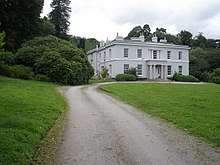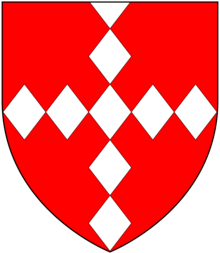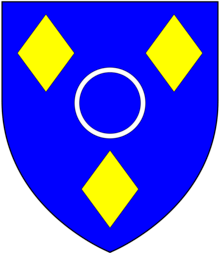Parke, Bovey Tracey

Parke is an historic estate in the parish of Bovey Tracey in Devon, England. The present mansion house known as Parke House, a grade II listed building[1] situated 1/2 mile west of the centre of the town of Bovey Tracey[2] and on the opposite side of the River Bovey, was rebuilt in 1826/8 by William Hole (1799-1859) and is today the headquarters of the Dartmoor National Park Authority.
Descent
Eveleigh
It was the seat of Nicholas Eveleigh (d.1620),[3] an utter barrister, who served as Steward of the Stannary Court of Ashburton, Devon.[4] He died aged 56 when the roof of Chagford Stannary Courthouse collapsed, killing him and nine others. His "sumptuous"[5] monument with an effigy survives in Bovey Tracey Church.
Hele
Eveleigh's widow married the lawyer Elize Hele (1560–1635)[6] (also seated at Fardel[7] in the parish of Cornwood, Devon), who founded Plympton Grammar School[8] (alias Hele's School). An elaborate monument with an effigy to Elize Hele survives in Bovey Tracey Church, facing that of Eveleigh.
Stawell

Sir John Stawell (1625-1669)
Sir John Stawell (1625-1669) of Parke, a counsellor-at-law,[9] in 1653[10] purchased Torre Abbey in Devon from Weston Ridgeway, 3rd Earl of Londonderry (1620–1672) of Tor Mohun, adjoining Torre Abbey, and was the owner in 1661 as the bird's eye engraving of that date by Wenceslaus Hollar confirms in a dedicatory canton, showing a strapwork escutcheon of the Stawell arms (Gules, a cross lozengy argent, with a martlet for the difference of a 4th son) below which is inscribed in Latin:
- Ut prisca majorum pietas memoretur posuit Johannes Stowell de Bovy Tracy in com(itatu) Devon(iensis) Armiger ("In order that the ancient piety of our forefathers should be remembered, John Stowell of Bovey Tracey, Esquire, placed this").
He sold Torre Abbey in 1662[11] to Sir George Cary (1611-1678), whose first cousin Sir Henry Cary, Sheriff of Devon in 1637, had sold the family's ancient seat of Cockington, situated about one mile west of Torre Abbey. In 1666 he purchased a moiety of the manor and borough of Ashburton, about 7 miles south west of Bovey Tracey. This purchase (what was later termed a pocket borough) enabled his son to be elected nine times a Member of Parliament for the borough of Ashburton.
He founded the "Stawell Gift", comprising £10 per annum to be spent on linen cloth for fifty poor people in the parish of Bovey Tracey chosen by the trustees and distributed on Christmas Day after the morning service.[12] Together with Rev. James Forbes he restored the 15th century roof of the south porch of Bovey Tracey Church, and their arms are shown as corbels on the ends of the arch around the doorway.[13] The senior line of the Stawell family was seated at Cothelstone in Somerset and another branch was seated at Sutcombe and Wike Stowell, Devon. He should not be confused with his kinsman and contemporary Sir John Stawell (1600-1662) of Cothelstone in Somerset, a Member of Parliament and Royalist governor of Taunton during the Civil War.
He married Sarah Stephens, a daughter of Nathaniel Stephens (1589-1660), of Eastington in Gloucestershire, twice a Member of Parliament for Gloucestershire.[14] He had at least three sons, the eldest of whom, William Stawell (c.1651-1702), MP, erected a mural monument to his father and younger brother in Bovey Tracey Church, displaying the arms of Stawell and inscribed below in Latin as follows:
- M(emoriae) S(acrum) D(omino) Johanni Stawell Equitis Aurati qui morti succubuit anno 1669 aetatis suae 44. Nec non Johannis filii eius natu tertii qui hinc migravit Jan. 29 1674 aetatis suae 20. Pie posuit Gulielmus Stawell filius solum superstes. ("Sacred to the memory of Sir John Stawell, Knight Bachelor, who lay down to death in the year 1669, (in the year) of his age the 44th. And not least to John his third-born son who migrated hence on 29 January 1674 of his age 20. William Stawell, the only son surviving, placed this piously".)
William Stawell (c.1651-1702)
William Stawell (c.1651-1702), son and heir, of Parke, was elected nine-times a Member of Parliament for Ashburton in Devon,[15] due to his patronage derived from his ownership of a moiety of the manor and borough of Ashburton. He died unmarried.
(Dunning)
Pevsner suggests that Parke, Bovey Tracey, was a seat of the prominent lawyer and politician John Dunning, 1st Baron Ashburton (1731–1783),[2] but he appears to have confused it with a farmhouse called "Park" (7 miles south-west of Parke, Bovey Tracey) within his manor of Widecombe-in-the-Moor on Dartmoor, to which shortly after his acquisition of that manor he had "added a room or two".[16] This farmhouse he enlarged and transformed into a house called Spitchwick Park (to be distinguished also from Stickwick near Hennock, 2 miles north-east of Bovey Tracy, a seat of the Hole family).
Clapp
It was the seat of George Hunt Clapp (1756-1824), a barrister and a bencher of the Middle Temple, and in 1798 a governor for life of the Magdalen Hospital in London.[17] His inscribed mural monument survives in Bovey Tracey Church. His origins are revealed by the will of his grandfather George Hunt (d.1768) of Northwick, signed 31 October 1766. He leaves all his freehold lands and tenements in the parishes of North Bovey and Throwleigh, immediately upon his own decease, to "my grandson George Luxton, son of Thomas Luxton and Elizabeth his wife, my daughter, of Winkleigh, Esq.," with remainders to " my granddaughter Elizabeth Luxton, sister of the said G. L.," and "my granddaughter Mary Luxton, younger sister of the said G. L." He leaves Tarr Mill in S. T., immediately after his decease, to "my grandson George Hunt Clapp, son of Robert Clapp and Mary his wife, my youngest daughter, of Ottery St. Mary, gent.," with remainders to " my grandson Francis Hunt Clapp," and others.[18]
Hole

William Hole (1799-1859)
William Hole (1799-1859) of Stickwick (in the parish of Bovey Tracey, 2 miles north-east of that town), purchased the nearby estate of Parke in 1825.[19] He was the only son and heir of Robert Hole (1742-1822) who built Stickwick in 1780-2,[20] (son of William Hole (1701-1779) of Crownley, in the parish of Bovey Tracey, by his wife Anne Blatchford, daughter of Theophilus Blatchford) by his wife Anne Pitts (d.1809), a daughter of Joseph Pitts of Kiln in the parish of Drewsteignton, Devon.[21] He was educated at Harrow and in 1822 married Susan Kitson (d.1895), eldest daughter of Rev. William Kitson, of Shiphay, Devon.[22] In 1826/28[19] he demolished the ancient house at Parke and rebuilt it as the present surviving house.[23]
William Robert Hole (1831-1903)
William Robert Hole (1831-1903), Justice of the Peace, Deputy Lieutenant,[22] only son, a Chartered Accountant,[24] whose portrait is in the collection of the National Trust.[25] He was educated at Winchester and Eton. In 1875 he married Laetitia Parlby, a daughter of Rev. John Hall Parlby, JP, of Manadon, near Plymouth.[22] He died in a horse-riding accident on 7 February 1903. In 1905 his widow presented a stained glass window to Bovey Tracey Church in his memory, depicting the Resurrection, forming the east window of the Lady Chapel.[26]
William Gerald Hole (1881-1974)
Major William Gerald Hole (1881-1974), son, who was educated at Winchester and Merton College, Oxford. He served in the Devon Imperial Yeomanry (Royal 1st Devon Yeomanry[22]) at Gallipoli and in Palestine during World War I. In 1905 he married Mildred Bingley, daughter of Rev. John Bingley of Woodford, Torquay, by whom he had an only daughter and sole heiress (Mildred) Geraldine Hole (1908-2008),[22] who in 1939 married Fleetwood Hugo Pellew (1910-2008) of Coppelia House, Moreton Hampstead,[27] Devon (2nd cousin of Pownoll Irving Edward Pellew, 9th Viscount Exmouth (1908–1970)), and left one daughter. William Gerald Hole presented a stained glass window to Bovey Tracey Church depicting the Road to Emmaus, forming the south window of the Lady Chapel.[26]
He bequeathed the Parke estate, comprising the house and 239 acres, to the National Trust.[28][29][30]
Several inscribed mural monuments to the Hole family of Parke, Stickwick and Crownley, survive in Bovey Tracey Church, also the east and south windows of the Lady Chapel, donated by the family.
Dartmoor National Park Authority
The mansion house of Parke is today leased to Devon County Council[19] as the headquarters of the Dartmoor National Park Authority.[2]
Further reading
- Gatehouse gazetteer, Parke, Bovey Tracey
- Molland, S., Historical Summary of Parke, Bovey Tracey for the National Trust (Report - Survey), SDV339545, 1996.
- Desmond, S. C., The Walled Garden at Parke, 5 (Report - Survey). SDV339546, 2007
- Clark, J. + Richardson, D., Parke (Un-published). SDV357925, 2013
- Hole, M.A. (apparently Mildred Ada Bingley, wife of William Gerald Hole (d.1974), owner of Parke), Sketches of Bovey Tracey: Bovey Tracey and District, 1930, pp. 37,45
References
- ↑ Listed building text
- 1 2 3 Pevsner, p.193
- ↑ Gatehouse gazetteer
- ↑ As stated in the lawsuit Foster v Courteney heard in the Star Chamber in June 1608, recorded in STAC 8/142/11, National Archives, Kew
- ↑ Pevsner, p.191
- ↑ Vivian, Lt.Col. J.L., (Ed.) The Visitations of the County of Devon: Comprising the Heralds' Visitations of 1531, 1564 & 1620, Exeter, 1895, p.467, pedigree of Hele
- ↑ Prince, John, (1643–1723) The Worthies of Devon, 1810 edition, London, p.487; also as inscribed on his ledger stone in Exeter Cathedral, as recorded in Prince, p.488
- ↑ Inscribed bronze plaque near building
- ↑ Per History of Parliament biography of his son William Stawell
- ↑ Rhodes, Michael, Devon's Torre Abbey: Faith, Politics and Grand Designs, Stroud, Gloucestershire, 2015, p.65
- ↑ Rhodes, p.65
- ↑ Source: PPT – ‘Statement of Significance’ re Church of St. Peter, St. Paul and St. Thomas of Canterbury, Bovey Tracey, pp.2-3
- ↑ Source: PPT – ‘Statement of Significance’, p.4
- ↑ http://www.historyofparliamentonline.org/volume/1604-1629/member/stephens-nathaniel-1589-1660
- ↑ History of Parliament biography of "STAWELL, William (c.1651-1702), of Parke, Bovey Tracey, Devon"
- ↑ Gray, Todd & Rowe, Margery (Eds.), Travels in Georgian Devon: The Illustrated Journals of The Reverend John Swete, 1789-1800, 4 vols., Tiverton, 1999, Vol.1, pp.102-3. Swete notes that at the time of his visit to Sandridge in the company of Sir Robert Palk, his host was then plain "Mr Dunning", placing the date before 1782 (a year before his death) when he was raised to the peerage, but also long before the building of the mansion at Park
- ↑ A List of the Governors of the Magdalen Hospital, 1798
- ↑ Devon and Cornwall Notes and Queries, Volume IX, (January 1916 to October 1917), p.24
- 1 2 3 http://www.heritagegateway.org.uk/Gateway/Results_Single.aspx?uid=MDV30583&resourceID=104
- ↑ "The original building account for Stickwick survives, showing that Robert Hole 'begun to lay the foundation' on 18 May 1780; most of the work was completed by January 1782, but the final bill was not paid until 25 October 1785. Chimneypieces were provided by Mr Robinson of Chudleigh. The parlour and parlour chamber were hung with paper. The roof was slated from the first. Lime ashes were used for the floors. Cost £591-10-8" (Listed building text )
- ↑ Burke's Genealogical and Heraldic History of the Landed Gentry, 15th Edition, ed. Pirie-Gordon, H., London, 1937, p.1137, pedigree of Hole of Parke
- 1 2 3 4 5 BLG, 1937, p.1137
- ↑ Pevsner, Nikolaus & Cherry, Bridget, The Buildings of England: Devon, London, 2004, p.193
- ↑ "CA", BLG, 1937, p.1137
- ↑ See image
- 1 2 Framed note in church
- ↑ https://www.pellew.com/Family%20Tree/Family%20Tree.htm#9th%20Viscount%20Exmouth%202
- ↑ http://www.nationaltrustcollections.org.uk/object/1296517
- ↑
- ↑